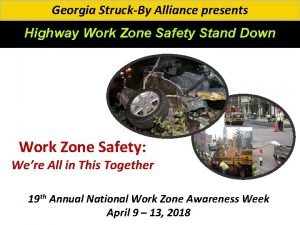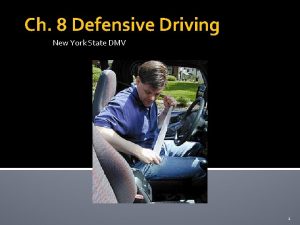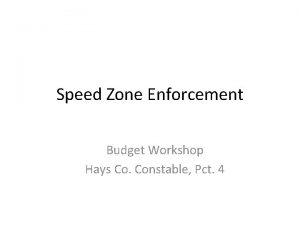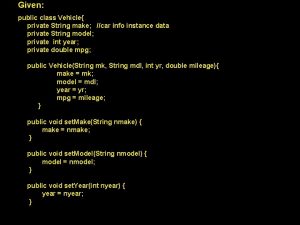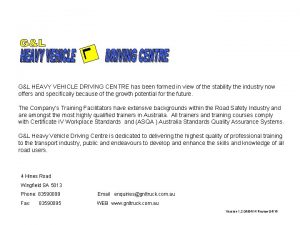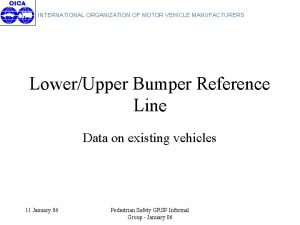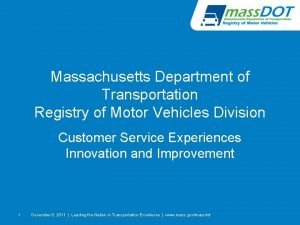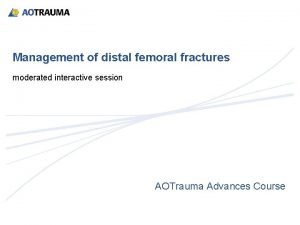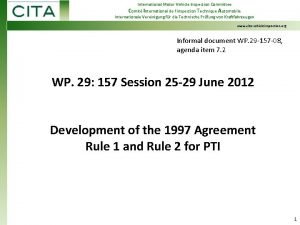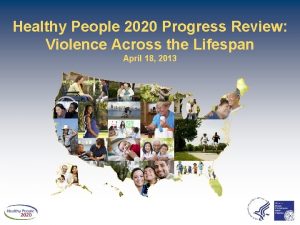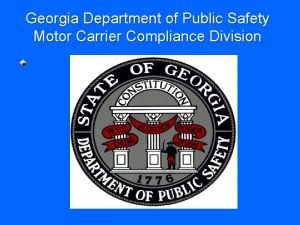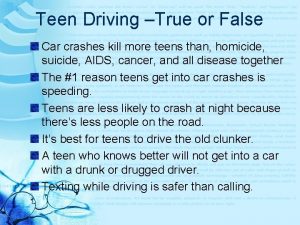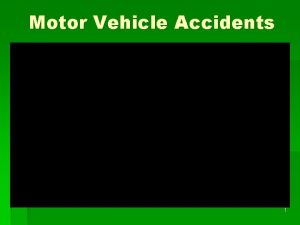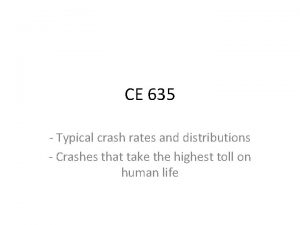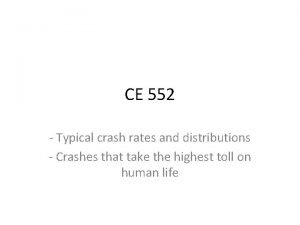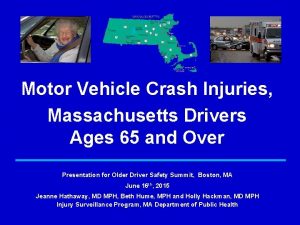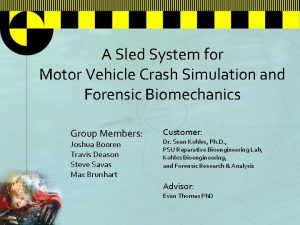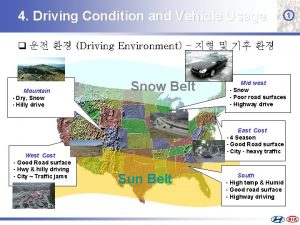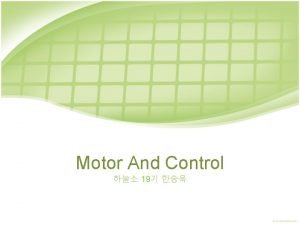Teen Driving and Motor Vehicle Crashes Crash Statistics









































- Slides: 41

Teen Driving and Motor Vehicle Crashes

Crash Statistics 2006 – Over 43, 000 Killed In Crashes Nationwide n 2006 – Over 770 Killed In Crashes In NJ n 2006 – Over 300, 000 Crashes Reported In NJ n

Cause of Death Age 16 -20 NHTSA 2003 #1 - MV Traffic Crashes (5, 988) n #2 – Homicide (2, 489) n #3 – Suicide (1, 813) n #4 - Accidental Poisoning (752) n #5 – Cancer (749) n

Cause of Death Age 16 -20 NHTSA 2003

MV Crashes #1 Cause of Death for Youths 16 -20 Approx 1/3 Of All Deaths In This Age Group. n More Than #2 - #5 Combined n Why? n – Inexperience – Easily Distracted n Driver Inattention #1 Cause Of Fatal Collisions In NJ

What Can We Do?

The Three E’s Engineering n Enforcement n Education n

Avoiding Crashes We Must Know Our Limitations n Human Limitations n Vehicle Limitations n

Human Limitations n Physical Limitations n Mental Limitations

Three Collisions Human Limitations n Vehicle Collision – Initial Crash n Human Collision – Body Into Interior Of Vehicle n Internal Collision – Internal Injuries/Lacerations – Transection of Aorta – Brain Injuries

Cranial Cavity

Three Collisions

Three Collisions Human Limitations n Speed Kills? – Sudden Stop – Tremendous Forces n Multiply Weight By Speed – Delta V (Velocity Change) – Occupant Restraints Increase Time During Delta V

Reducing Forces of the Human Collision Occupant Restraints n Seat Belts n Air Bags n

Occupant Restraints Reducing The Effect Of The Human Collision Decrease Injury By Increasing Delta V Time n Hold Occupants In Place During Collision n Unrestrained Occupants Act As Human Bullets n

Occupant Restraints Reducing The Effect Of The Human Collision n Lap Belt – Hold Occupant In Position n Shoulder Harness – Stops Jack Knife Effect n Air Bag – Prevents Head Strikes

Perception And Reaction Human Limitations n What Is It? – Time Needed To Perceive And React – No Instant Reactions n How Long? – 1. 5 Seconds Average n Daytime n Experienced Drivers

Visual Acuity Human Limitations n Eye Function – Rods Vs Cones n Rods – Are More Sensitive – Not Sensitive To Color n Cones – Sensitive to Color – Fovea Centralis (All Cones)

Visual Acuity Human Limitations

Conspicuity At Night n Reduced Lighting – Shades Of Grey – Over Driving Headlights – Pedestrian Visibility

Vehicle Limitations Traction n Braking n Lateral Acceleration (Cornering) n

Vehicle Handling n Friction And Handling – Friction Circle Straight Roads n Curves n – Inertial Forces – Critical Curve Speed

Friction Circle

Limitations Human n Vehicle (Mechanical) n Driving Is A Learned Behavior n New Drivers Need More Time To React n More Time n – Increased Following Distances – Reduced Speeds

Perception And Reaction Human Limitations n What Is It? – Time Needed To Perceive And React – No Instant Reactions n How Long? – 1. 5 Seconds Average n Daytime n Experienced Drivers

Perception And Reaction n More Time Needed For: – Night – Inexperienced Drivers – Adverse Weather n Following Distance – 2 Seconds – More For New Drivers

Speed Issues Speed Is A Contributing Factor In Most Serious And Fatal Crashes n Speed Increases Stopping Distance n – Perception/Reaction – Braking Speed Decreases Percep/React Time n Speed + Reduced Visibility = Bad n – Night, Rain, Snow, Fog

Speed Issues How Fast Are We Really Going n MPH or FPS n MPH * 1. 466 = FPS n

Speed Issues MPH vs. FPS n 25 mph = 36. 65 fps n 35 mph = 51. 31 fps n 45 mph = 65. 97 fps n 55 mph = 80. 63 fps n 65 mph = 95. 29 fps n 75 mph = 109. 95 fps n

Speed Issues n n n n Perception/Reaction Distance Speed * 1. 466 * 1. 5 sec 25 mph – 54. 9 Feet 35 mph – 76. 9 Feet 45 mph – 98. 9 Feet 55 mph – 120. 9 Feet 65 mph – 142. 9 Feet 75 mph – 164. 9 Feet

Speed Issues Braking Distance n Dependent on Speed and Surface Friction n Lower Friction Increases Braking Distance n Dry Roads Have Highest Friction n

Speed Issues Roadway Friction Values (Approx) n Dry Pavement f=0. 6 to 0. 8 n Wet Pavement f=0. 45 to 0. 65 n Snow Covered f=0. 3 to 0. 55 n Ice Covered f=0. 05 to 0. 2 n

Speed Issues n Braking Distance Formula

Speed Issues Dry Pavement Braking (f=0. 7) n 25 mph – 29. 7 Feet n 35 mph – 58. 3 Feet n 45 mph – 96. 4 Feet n 55 mph – 144 Feet n 65 mph – 201. 1 Feet n 75 mph – 267. 8 Feet n

Speed Issues Dry Pavement Braking (f=0. 7)

Speed Issues Slide to Stop n Different Surfaces at 45 mph n Dry - 96. 4 Feet (f=0. 7) n Wet – 122. 7 Feet (f=0. 55) n Snow – 168. 7 Feet (f=0. 4) n Ice – 337. 5 Feet (f=0. 2) n

Total Stopping Distance n Combine – Perception/Reaction Distance – Braking Distance

Stopping Distance Dry Pavement Percep/React + Braking=Total Stop D n 25 mph – 84. 6 Feet n 35 mph – 135. 2 Feet n 45 mph - 195. 3 Feet n 55 mph – 264. 9 Feet n 65 mph – 344 Feet n 75 mph – 432. 7 Feet n

Big Brother Is Watching Crash Reconstruction n Calculating Speed From: n – Tire Marks – Crush Damage – Momentum Analysis – Computer Modeling Air Bag Module n Car Chip n

Legal Consequences Tickets n Suspension n Increased Insurance Costs n Criminal Consequences n – Accident While Suspended – Vehicular Assault – Vehicular Homicide

 Welcome to teen challenge uk - teen challenge uk
Welcome to teen challenge uk - teen challenge uk Partners for safe teen driving
Partners for safe teen driving Most work zone crashes
Most work zone crashes Most work zone crashes dmv
Most work zone crashes dmv Speeding crashes
Speeding crashes Public class vehicle
Public class vehicle Tlik2003
Tlik2003 Depreciation motor vehicle
Depreciation motor vehicle Car bumper height
Car bumper height Canadian motor vehicle safety standards
Canadian motor vehicle safety standards Massachusetts department of transportation
Massachusetts department of transportation What fracture
What fracture International motor vehicle inspection committee
International motor vehicle inspection committee 2020 motor vehicle deaths
2020 motor vehicle deaths General
General Motor carrier compliance division
Motor carrier compliance division What is a motor unit
What is a motor unit Introduction to statistics what is statistics
Introduction to statistics what is statistics Pony motor starting synchronous motor
Pony motor starting synchronous motor What is hunting in synchronous motor
What is hunting in synchronous motor Motor parts name
Motor parts name Pony motor starting synchronous motor
Pony motor starting synchronous motor Teen nnn
Teen nnn Explorica teen tours
Explorica teen tours Volumetric efficiency of ic engine
Volumetric efficiency of ic engine Teen fads
Teen fads Veertig sinkplate teen die suidewind
Veertig sinkplate teen die suidewind Teen portal nn
Teen portal nn Safety plan teen
Safety plan teen Chapter 11 managing weight and eating behaviors
Chapter 11 managing weight and eating behaviors Gauravkumar13
Gauravkumar13 Teen nn
Teen nn Teen movie genres
Teen movie genres Teen challenge mission statement
Teen challenge mission statement Sexual wholeness toolkit
Sexual wholeness toolkit Which illustrates an emotional aspect of teen sexuality?
Which illustrates an emotional aspect of teen sexuality? Teen coin
Teen coin Teen biz 3000
Teen biz 3000 Teen film genre
Teen film genre Não jogue sua vida fora
Não jogue sua vida fora Teen challenge monterey bay
Teen challenge monterey bay Teen brain claims
Teen brain claims


